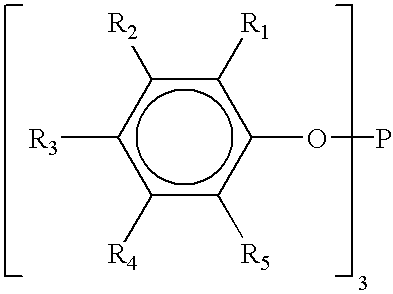Phosphite additives in polyolefins
a polyolefin and additive technology, applied in the field of polyolefins, can solve the problems of deformation of polymers, deformation of polymers, and loss of impact strength, and achieve the effect of improving color and stability
- Summary
- Abstract
- Description
- Claims
- Application Information
AI Technical Summary
Benefits of technology
Problems solved by technology
Method used
Image
Examples
examples
[0142]The following examples are provided to assist a person skilled in the art with further understanding of this invention. These examples are intended to be illustrative of the invention but are not meant to be construed as limiting the reasonable scope of the invention.
[0143]Chemical compounds utilized in these examples are summarized below:
[0144]A. bis(2,4-dicumylphenyl)pentaerythritol diphosphite, commercially available as Doverphos® S-9228, which is a registered trademark of Dover Chemical Company;
[0145]B. tris-(2,4-di-tert-butylphenyl)phosphite commercially obtained as DoverPhos® S-480, which is a registered trademark of Dover Chemical Company;
[0146]C. tris(2,4-di-tert-butylphenyl)phosphite, commercially available as Irgafos® 168, which is a registered trademark of Ciba Specialty Chemicals Company;
[0147]D. bis (2,4-di-t-butylphenyl)pentaerythritol diphosphite, commercially available as Ultranox® 626, which is a registered trademark of General Electric Co.;
[0148]E. bis (2,4-d...
example i
[0154]700 mg of Anox 20 per kg of polyethylene and 300 mg of ZHT-4D per kg of polyethylene were dry blended together with varying amounts of Doverphos S-9228 and Doverphos S-480 for about two minutes to make different stabilization packages.
[0155]A total package of 1300 mg of Doverphos S-9228, Doverphos S-480, Anox 20, and ZHT-4D were added per kg of polyethylene during an extruding process producing a stabilized polyethylene composition. A twin screw extruder with four separate temperature zones was utilized. Zone one was at 190° C., zone two was at 210° C., zone three was at 220° C., and zone 4 was at 215° C. The extruder screws rotated at 25 revolutions per minute (rpm). After extruding said stabilized polyethylene composition, each strand was pelletized and placed in a sample carton.
[0156]Samples of each stabilized polyethylene composition were analyzed by a Hunter Lab D25 Optical Sensor purchased from Hunter Associate Laboratory, Inc. This analysis provided Hunter “a” and Hunte...
example 2
[0164]The indicated phosphites and phosphite blends in Table III were tested to determine the percentage weight gain due to moisture absorption over a period of 7 days.
[0165]The percentage weight gain was calculated by initially weighing 2000 mg of a particular phosphite or blend of phosphites. Then, the phosphite or phosphite blend was placed in a humidity oven manufactured by Blue M (Model #POM-75700-1). The humidity oven was operated at 45° C. and 95% relative humidity. After each day, the phosphite sample was weighed. The percentage weight gain was calculated by the following formula: % Weight Gain=(Weight after time in oven)-Initial Weight)(Initial Weight)
The data are tabulated below in Table III.
[0166]
TABLE IIIAdditive% Weight Gain-Each DayRunPackage1234567300A18232.9333463741.5310B51017273134.538320C11.5121717.215.515.715.9330D4.845.57.565.46.0Additive Packages: A: 71 wt % Anox 20 and 29 wt % Alkanox P-24; B: 70 wt % Irganox 1010; 23 wt % Ultranox 626; 7 wt % ...
PUM
| Property | Measurement | Unit |
|---|---|---|
| percentage weight gain | aaaaa | aaaaa |
| diameter | aaaaa | aaaaa |
| diameter | aaaaa | aaaaa |
Abstract
Description
Claims
Application Information
 Login to View More
Login to View More - R&D
- Intellectual Property
- Life Sciences
- Materials
- Tech Scout
- Unparalleled Data Quality
- Higher Quality Content
- 60% Fewer Hallucinations
Browse by: Latest US Patents, China's latest patents, Technical Efficacy Thesaurus, Application Domain, Technology Topic, Popular Technical Reports.
© 2025 PatSnap. All rights reserved.Legal|Privacy policy|Modern Slavery Act Transparency Statement|Sitemap|About US| Contact US: help@patsnap.com



